Date September 52 BC | ||
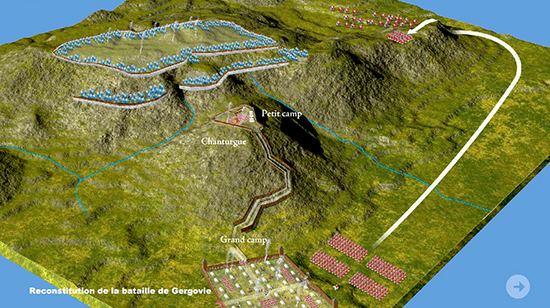 | ||
Similar Battle of Alesia, Gallic Wars, Avaricum, Battle of Bibracte, Battle of Pharsalus | ||
Battle of gergovia 52 bc
The Battle of Gergovia took place in 52 BC in Gaul at Gergovia, the chief oppidum (fortified town) of the Arverni. The battle was fought between a Roman Republican army, led by proconsul Julius Caesar, and Gallic forces led by Vercingetorix, who was also the Arverni chieftain. The Gauls won the battle.
Contents
- Battle of gergovia 52 bc
- The speech of vercingetorix after the battle of gergovia
- Prelude
- The battle
- References
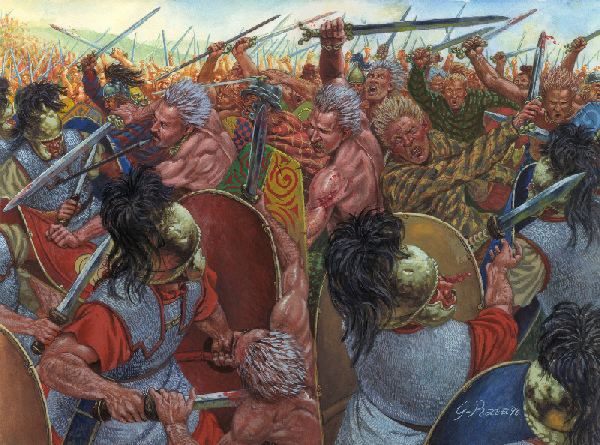
The site is identified with Merdogne, now called Gergovie, a village located on a hill within the town of La Roche-Blanche, near Clermont-Ferrand, in south central France. Some walls and earthworks still survive from the pre-Roman Iron Age. The battle is well known in France, as exemplified in the popular French comic "Asterix", where the battle is referenced, specifically in the book "Asterix and the Class Act".
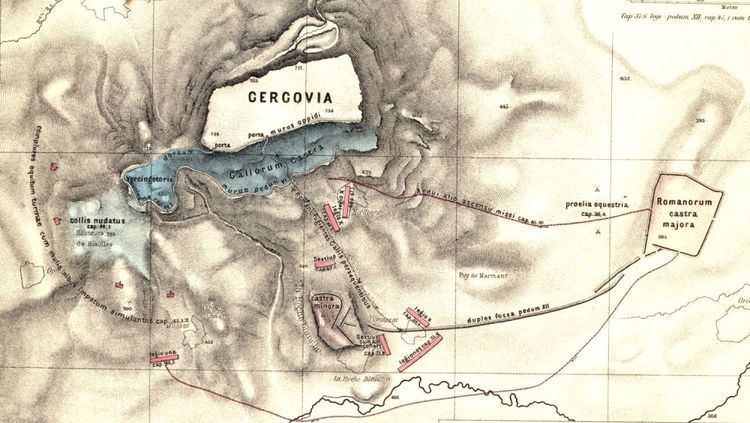
The speech of vercingetorix after the battle of gergovia
Prelude
As with much of the early history of Gaul, the knowledge of the war comes principally from Julius Caesar's Commentaries on the Gallic War (there are no surviving Gaulish accounts).
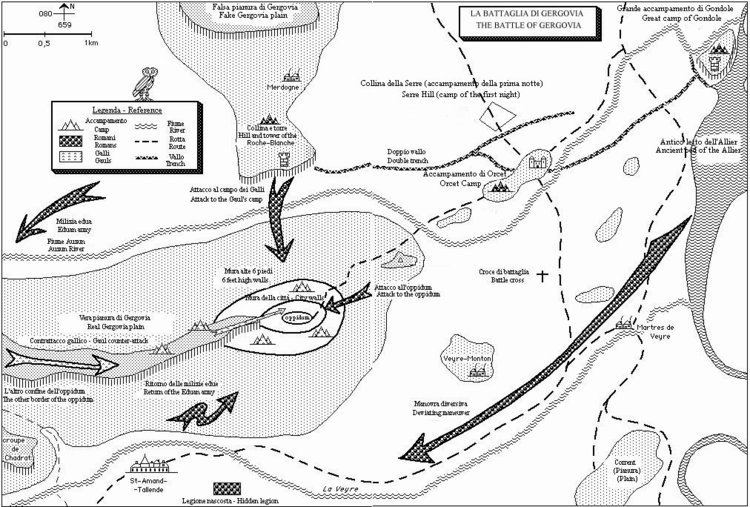
Vercingetorix had earlier been expelled from Gergovia. In winter 53 BC, whilst Caesar was gathering his forces for a strike against the Gauls, Vercingetorix attacked Gergovia. Caesar states that this left him with a difficult decision, between keeping his forces safe over the winter but showing Roman weakness in defending her allies the Aedui and thus losing their support, or bringing Vercingetorix to open battle but risking running out of supplies—he chose the latter.
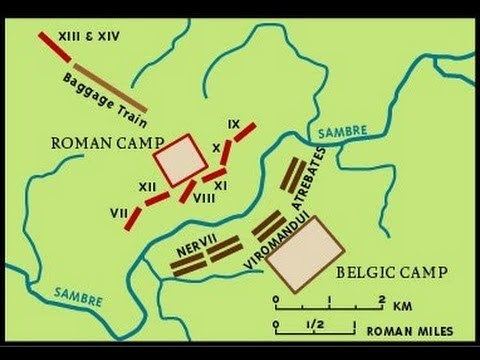
Leaving two legions and all his baggage train behind in Agedincum, Caesar led the remaining legions to Gergovia's aid. His sieges of Vellaunodunum, Genabum and Noviodunum en route caused Vercingetorix to lift his siege and march to meet Caesar in open battle at Noviodunum, which Caesar won. Caesar then besieged and captured Avaricum and resupplied there.
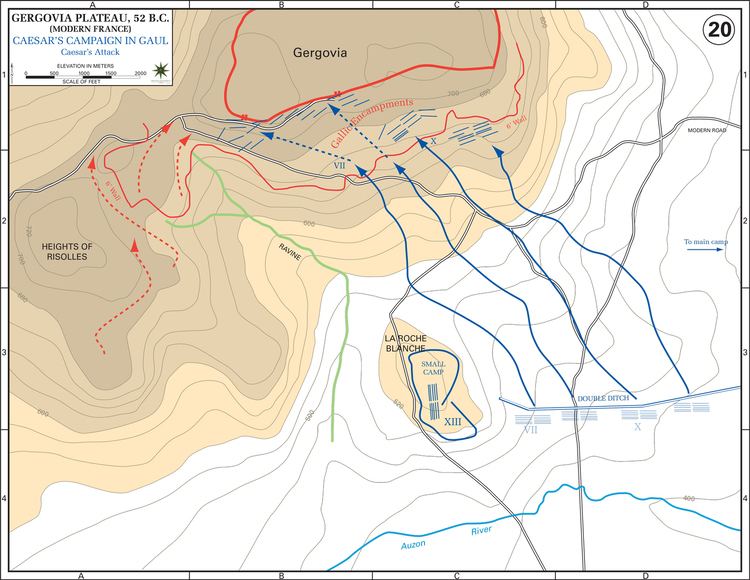
Caesar then set out in the direction of Gergovia, which Vercingetorix was probably able to guess once he had divined his direction. The heights of Gergovia itself stand twelve hundred feet above the plain that they overlook. It is a plateau that is a mile and a half long by a third of a mile wide. It was an advantageous place to hold, as there was only one way in, and a small body of troops could hold the entrance to the place. It was a reasonably easy guess to make.
Vercingetorix therefore crossed the river Elave, and started marching up and down the bank, mirroring Caesar's movements and destroying all the bridges to keep him from crossing, the purpose presumably being to destroy part of his force as he attempted to cross. Realizing Vercingetorix's plan, Caesar resolved to trick him and cross under his very nose.
Caesar one night camped near the town of Varennes, where there had previously been a bridge before Vercingetorix had destroyed it. That night, he divided his force into two parts, one part being 2/3rds of the force, the other being 1/3rd of the force. However, the larger force he ordered to march in 6 corps, as if it were in fact the full corps. He then ordered it to continue its march south. Vercingetorix, duped, took the bait and followed this part of the force.
Caesar, with the two legions still present at Varennes, speedily rebuilt the bridge that had been present there. He then sent for the other force, which during that next day stole a march on Vercingetorix, and completed a junction with the original force, and crossed the rebuilt bridge. Realizing that he had been duped, Vercingetorix set out south, to beat Caesar to Gergovia.
The battle
Five days later Caesar reached Gergovia, the first march being short because the majority of the troops were tired after marching up the river and back, and the last march because the legions arrived at the town. Realizing its mountainous location made a frontal assault risky, he decided to rely on his superior siege tactics. Upon arriving, Caesar discovered that there was a small hill that the Gauls held that was essential to their holding Gergovia itself. From there, they were able to provide water, corn and forage.
Caesar took this in a night raid, and swiftly stationed two legions upon this same hill. He then linked it to his main camp, by digging a double trench, twelve feet wide, and a parapet. The result of this was a wall that kept the Gauls from their supplies, which they desperately needed. They were forced to subsist on the meager glen that supplied water to Gergovia itself.
During the course of this siege, the Aedui nobles had been 'corrupted' by emissaries of Vercingetorix, with both gold and misinformation about the nature of Caesar's conquests, or so Caesar would have one believe. Caesar had earlier made an agreement with this tribe, to the effect that ten thousand men would protect his line of supplies. Vercingetorix convinced the chief Convictolitavis—who had previously been made chief of this tribe by Caesar—to order these same men to join him upon their arrival at the oppidum. They attacked the Romans who were accompanying their supply train, leaving Caesar in an embarrassing position.
His rations threatened, Caesar took four legions from the siege, surrounded the Aedui army and defeated it. The pro Roman faction retook control of the Aedui government and Caesar returned to Gergovia with 10,000 pro Roman Aedui horsemen. The two legions he had left to continue the siege were hard pressed to keep Vercingetorix's much larger force at bay.
Caesar realized that his siege would fail unless he could get Vercingetorix off the high ground. He used one legion as a decoy while the rest moved onto better ground, capturing three Gallic camps in the process. He then ordered a general retreat to lure Vercingetorix off the high ground. However, the order was not heard by most of Caesar's force. Instead, spurred on by the ease with which they captured the camps, they pressed on toward the town and mounted a direct assault on it. The Aedui arrived at that moment but the Romans mistook them for enemies at the beginning and Caesar had to make order in his lines. The noise of the assault alerted Vercingetorix who arrived and saw the Roman and Aedui just beneath the walls of Gergovia. Vercingetorix then led a cavalry charge which crushed the Roman lines. After the cavalry charge, the warriors left their horses and joined the infantry who were fighting the Romans, who had suffered heavy casualties. Given the importance of the disaster Caesar ordered a retreat. In the wake of the battle, Caesar lifted his siege and fled the Arverni lands in the direction of Aedui territory.
